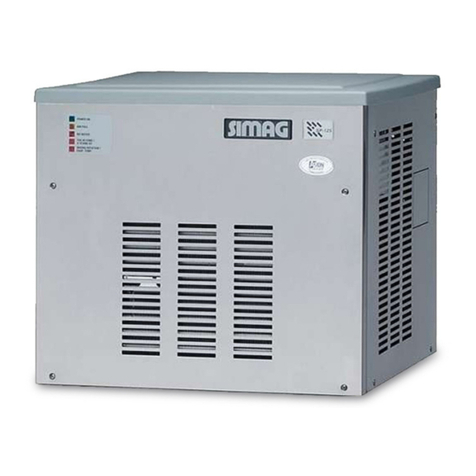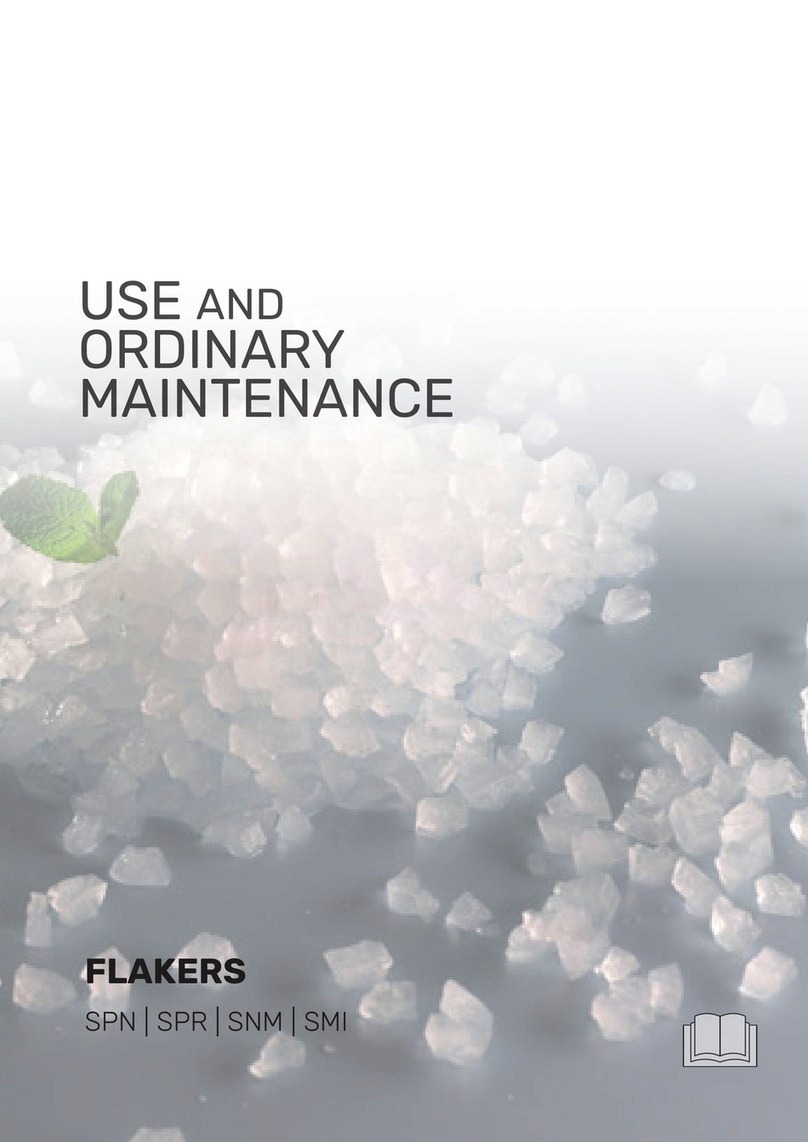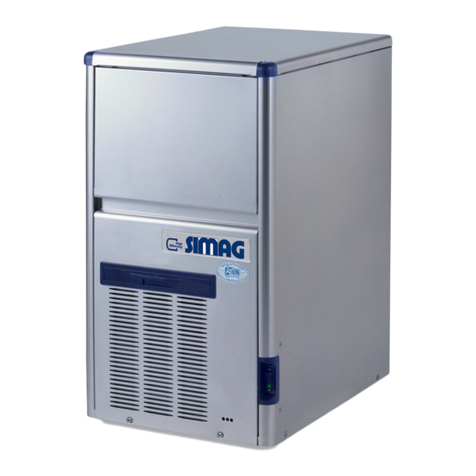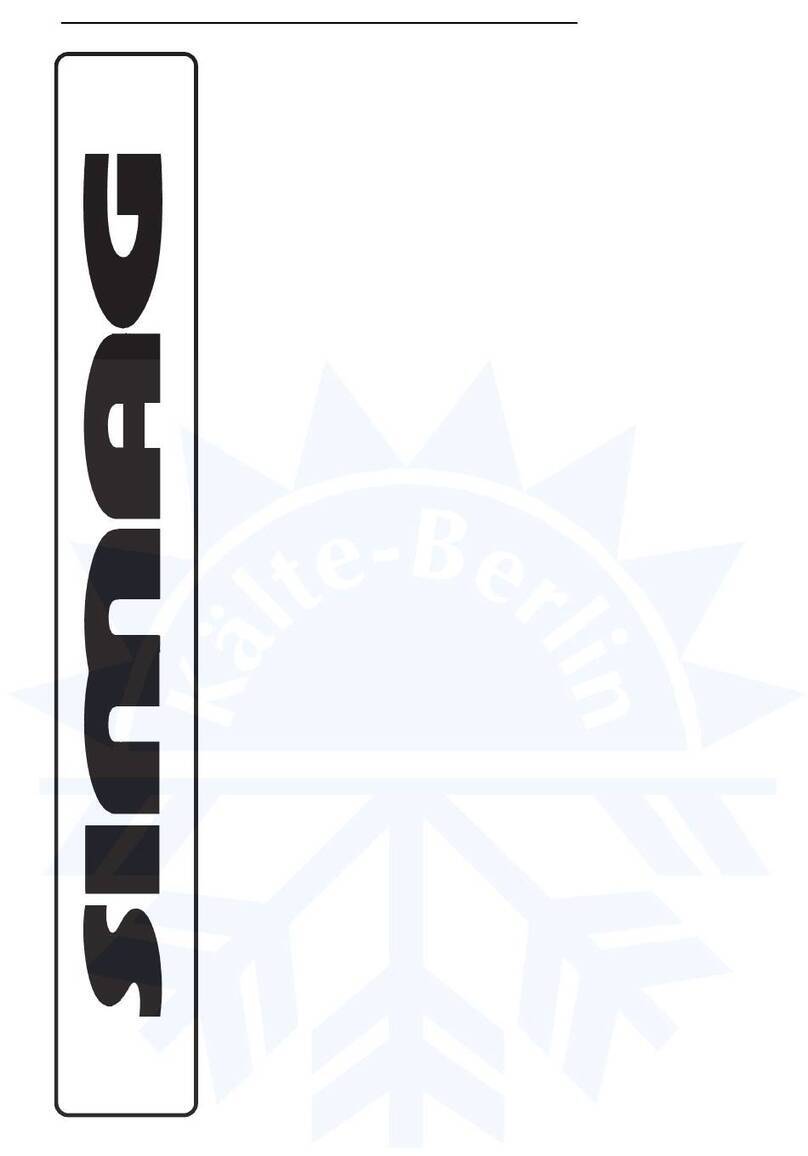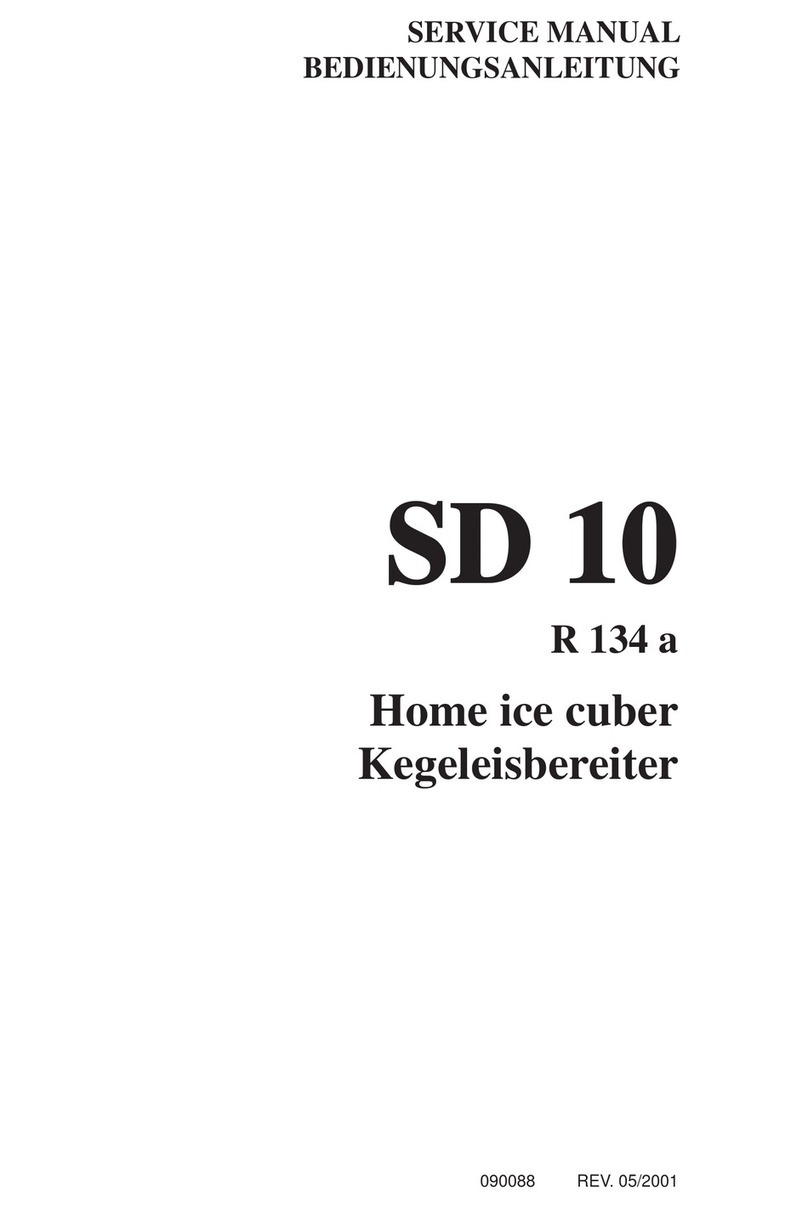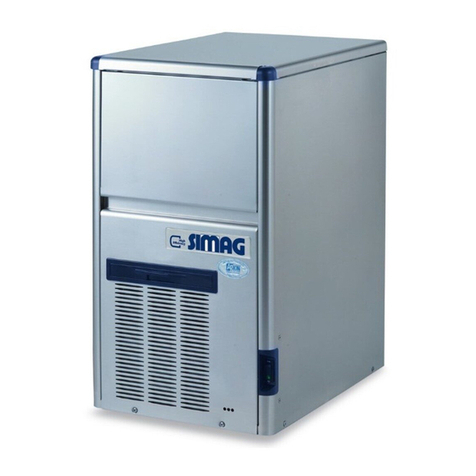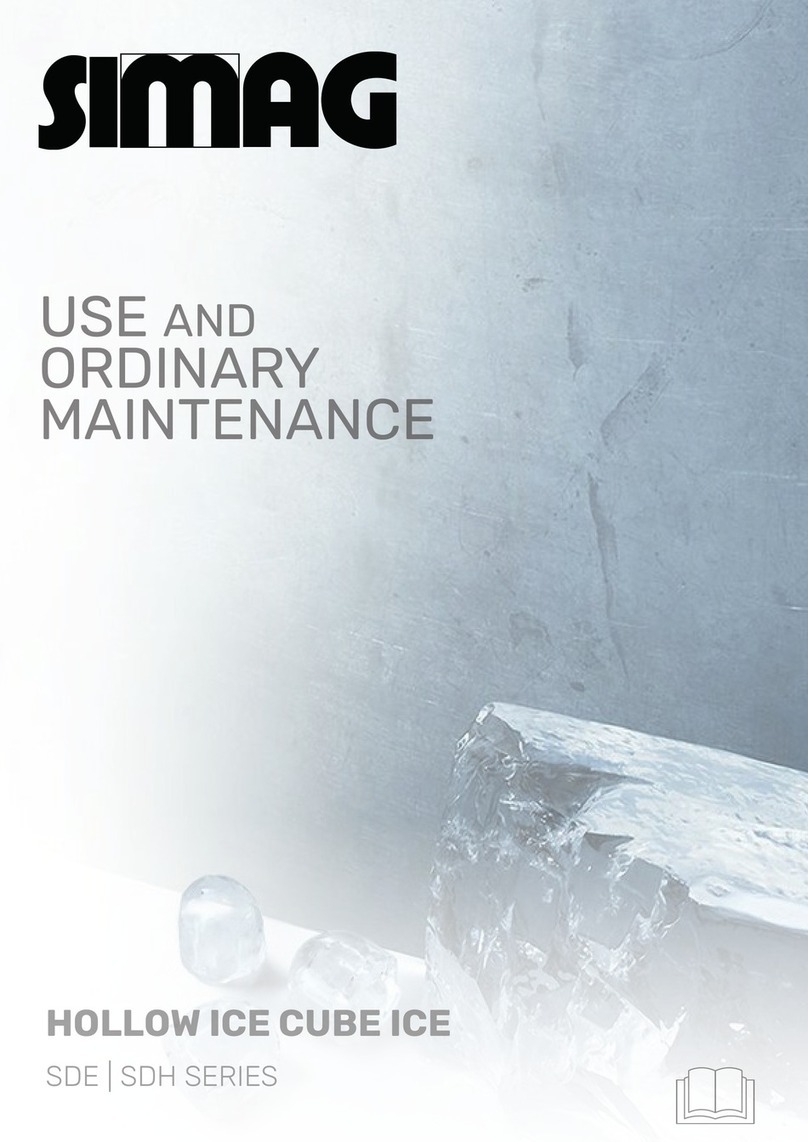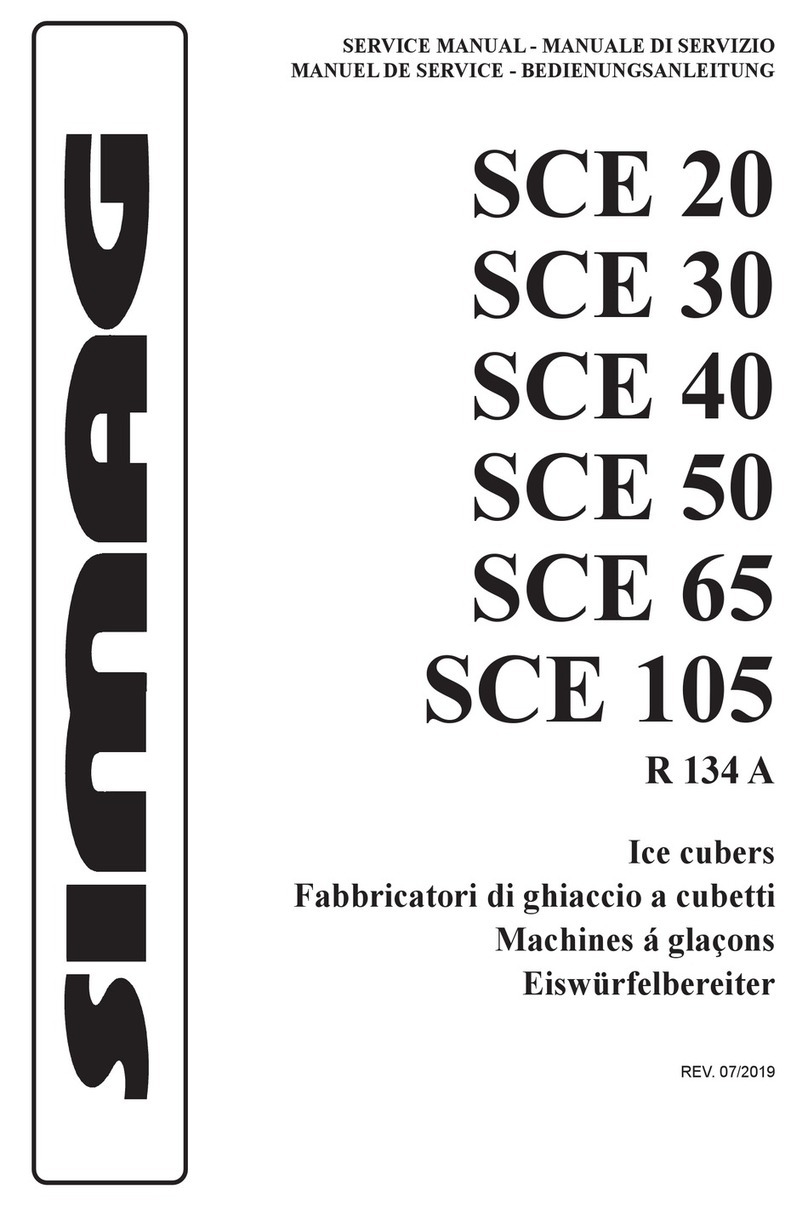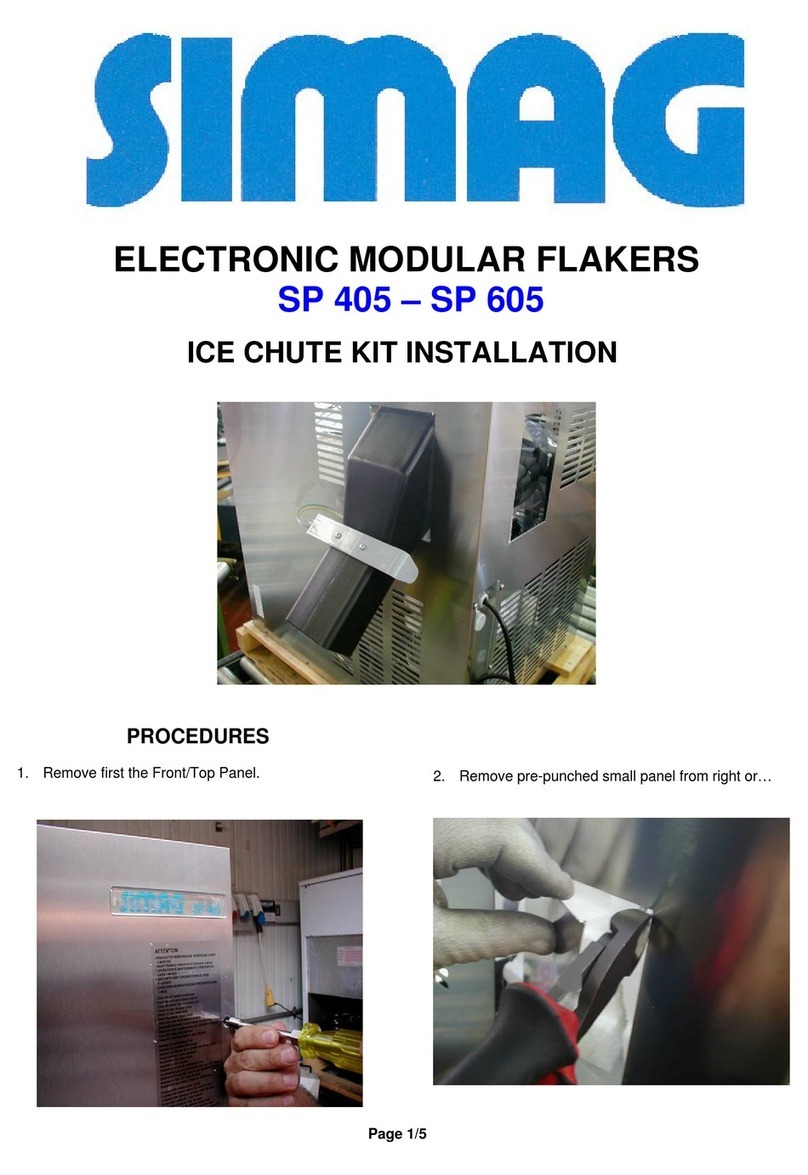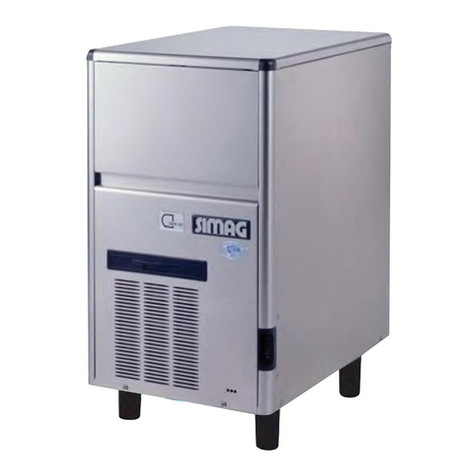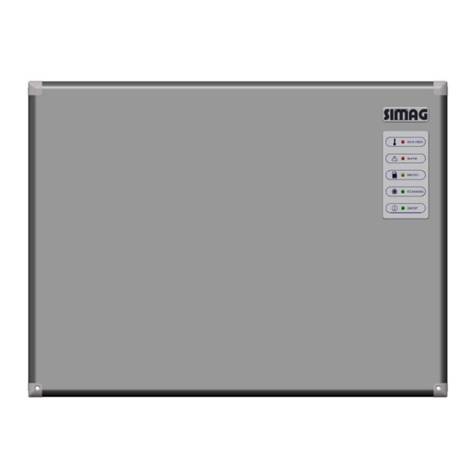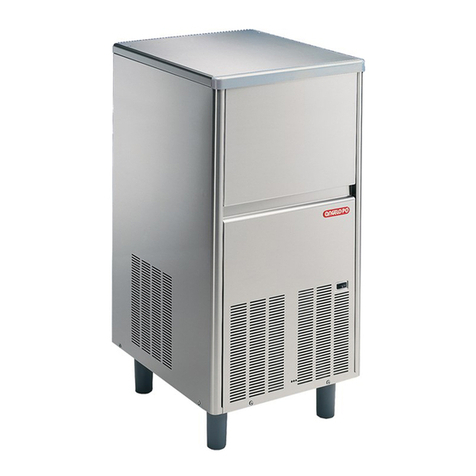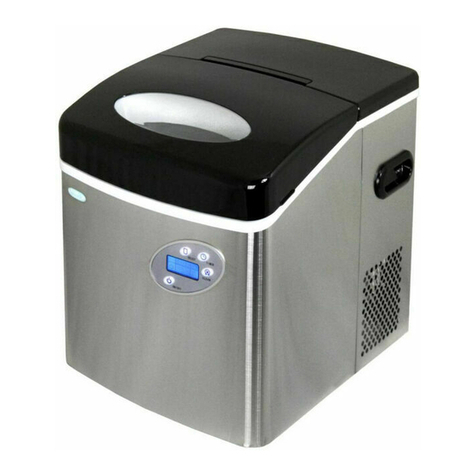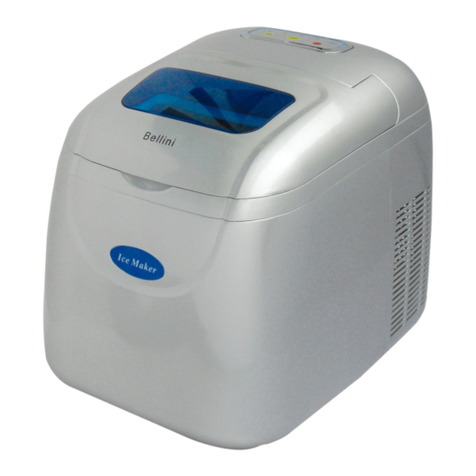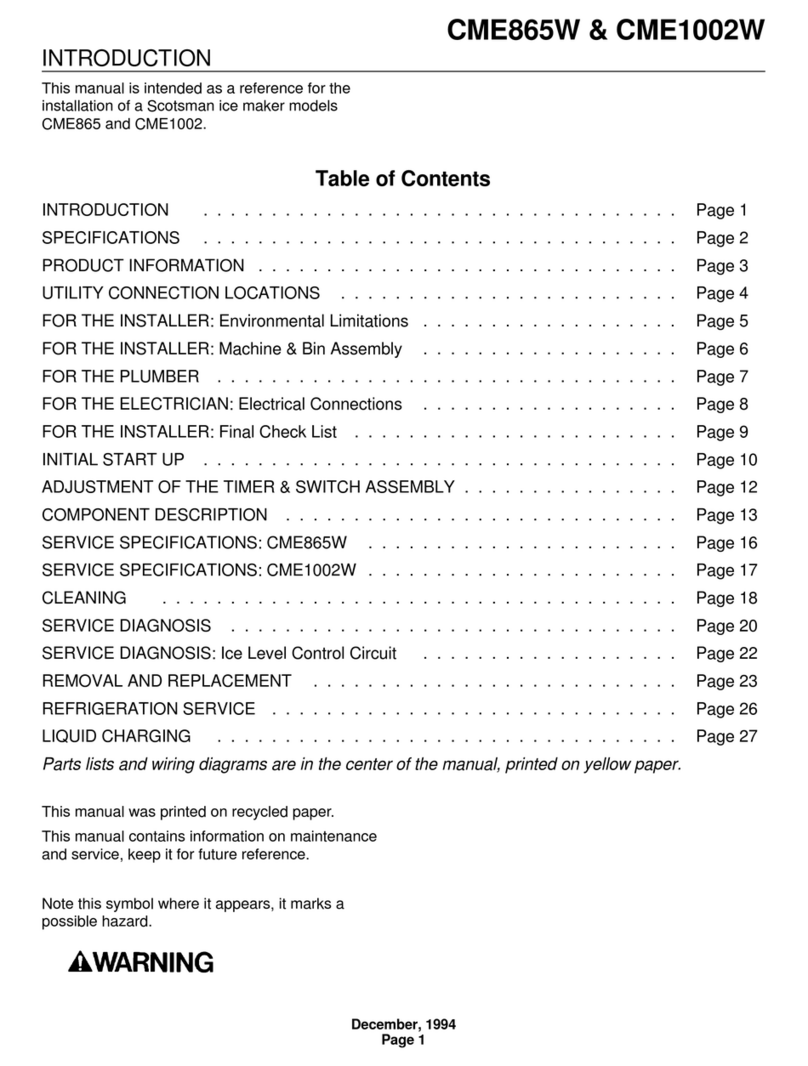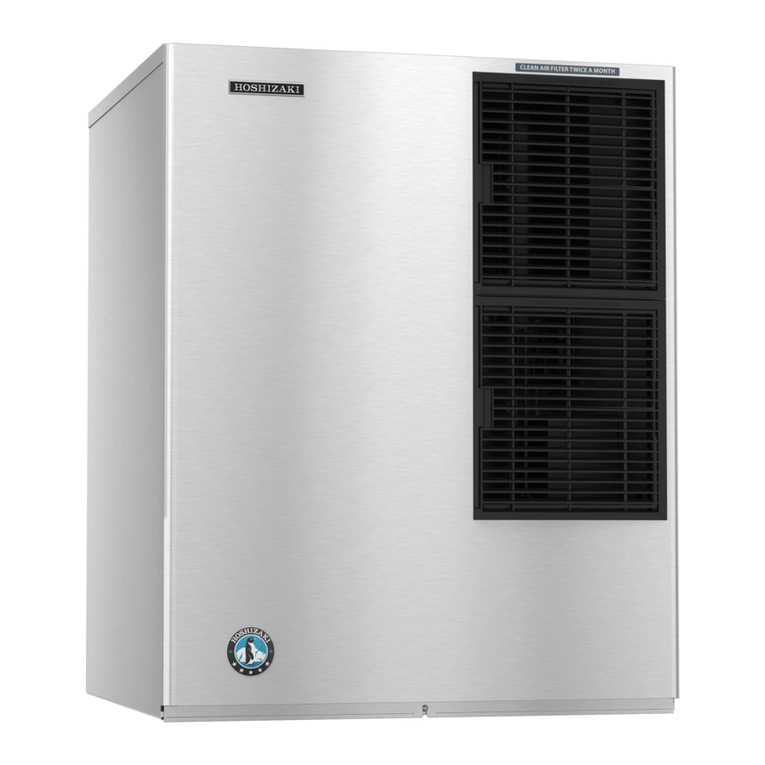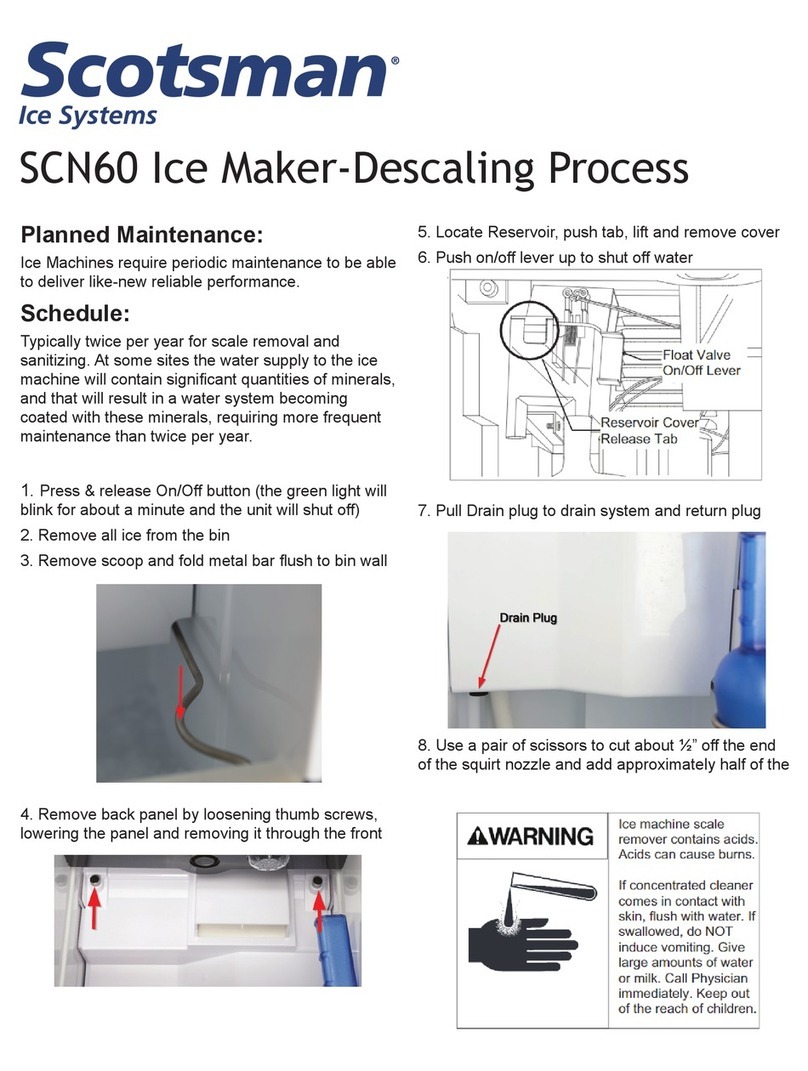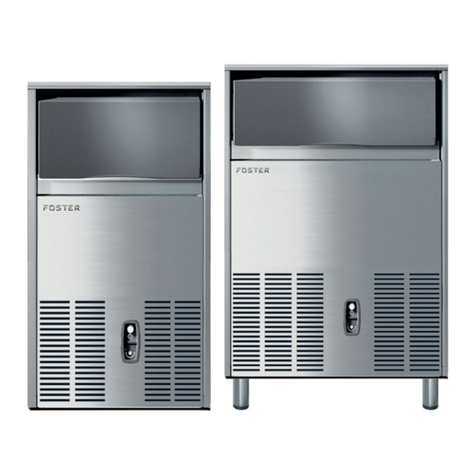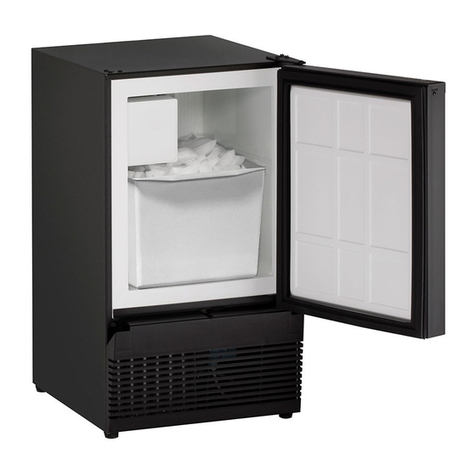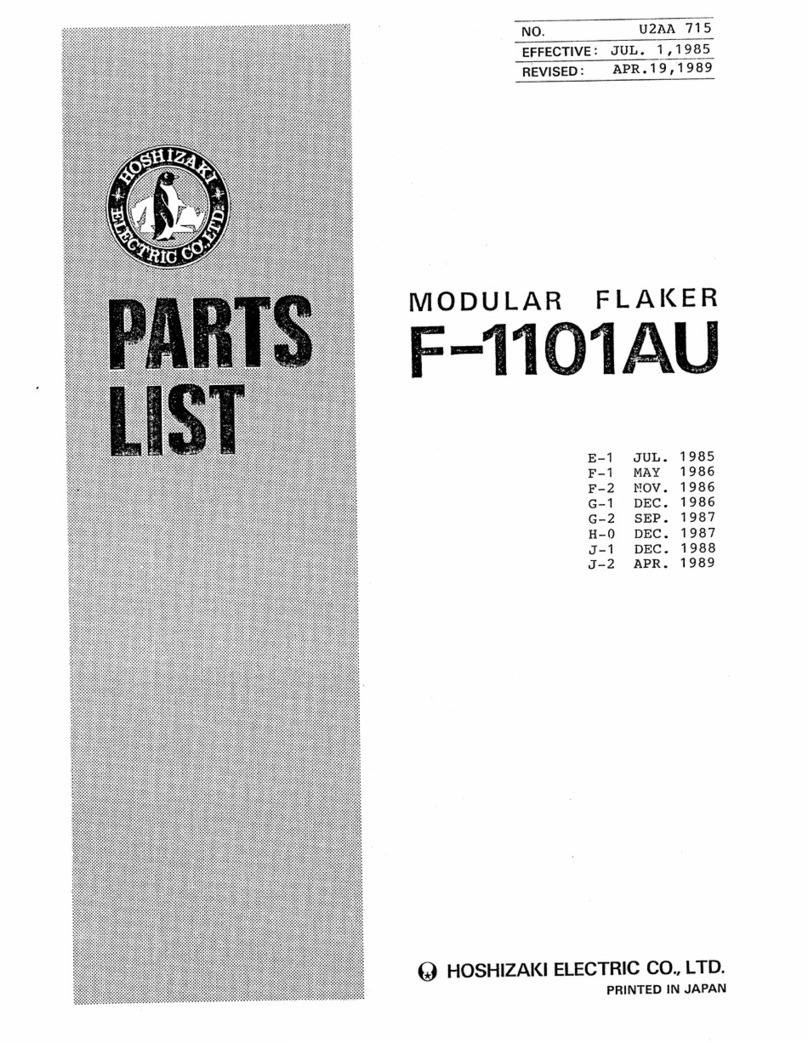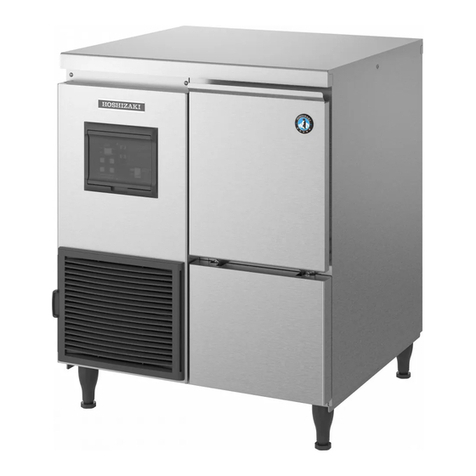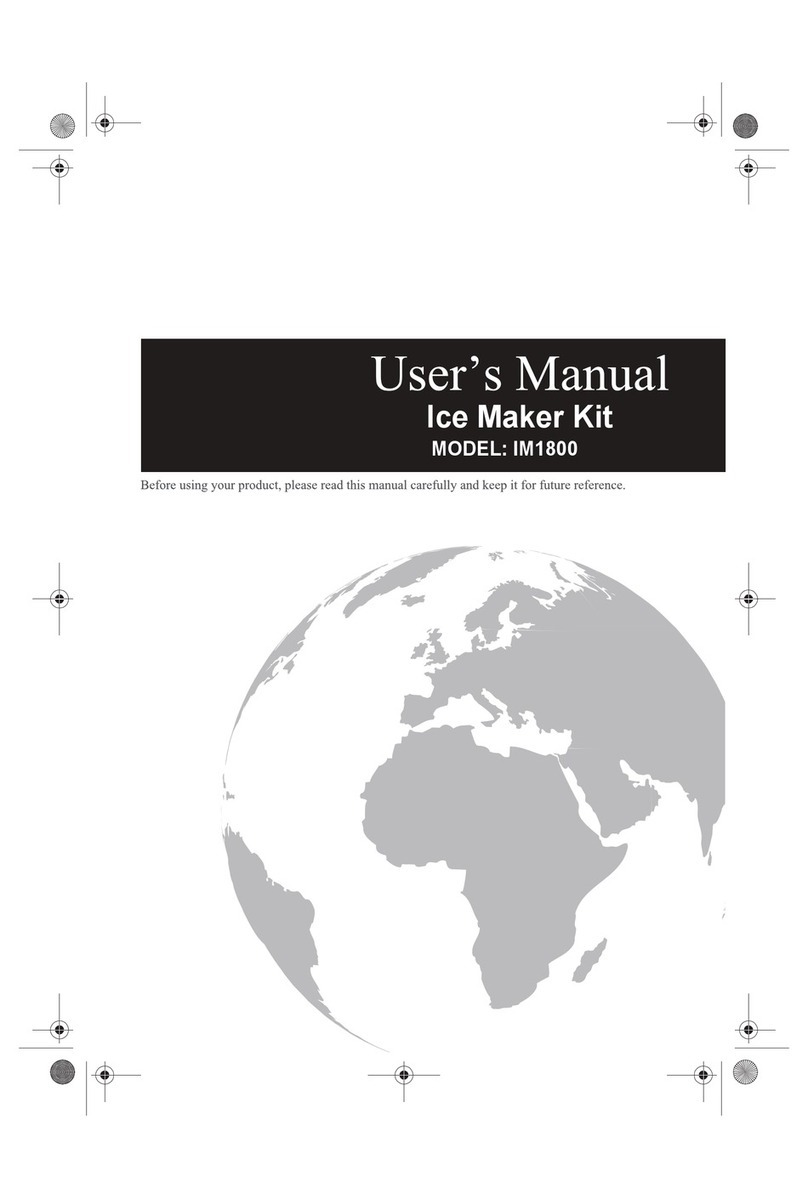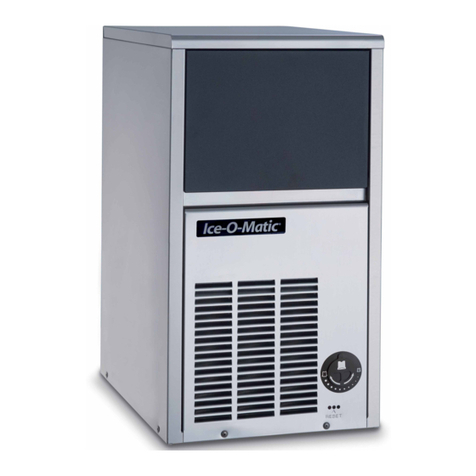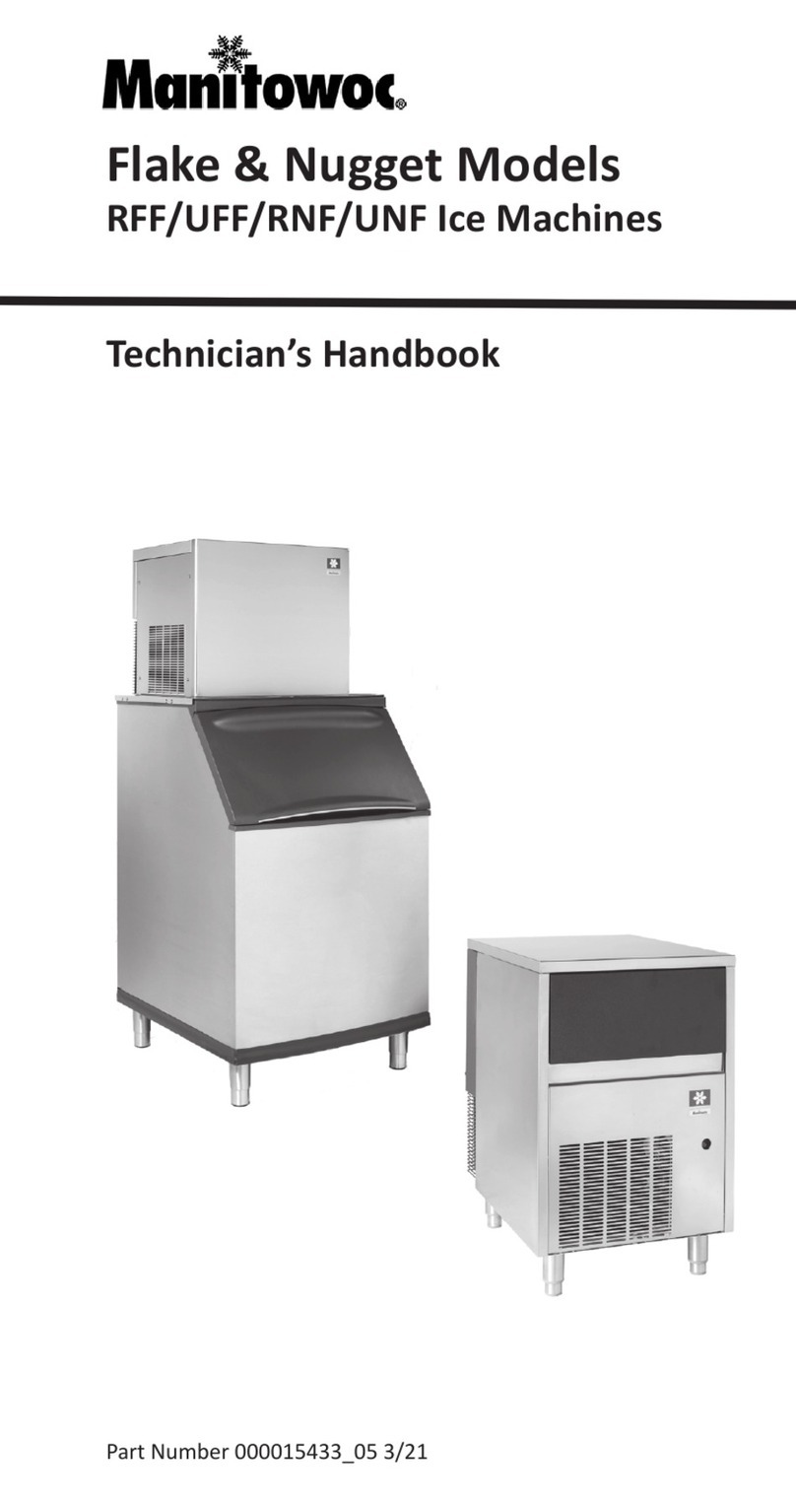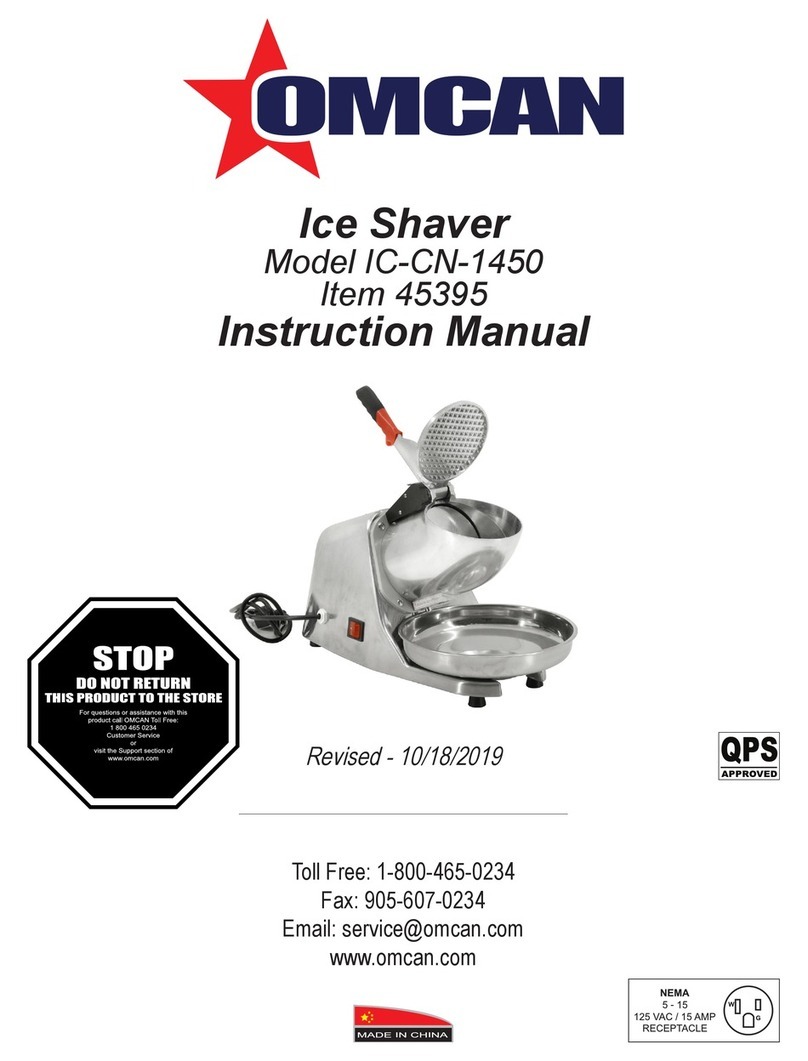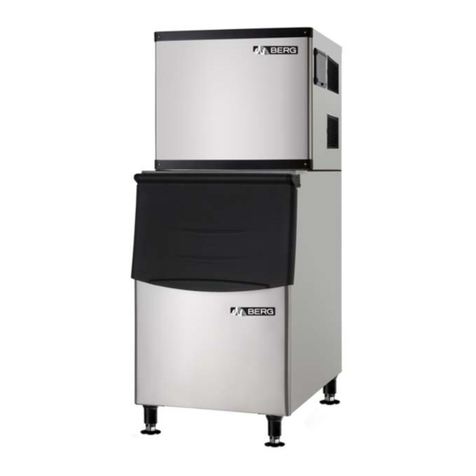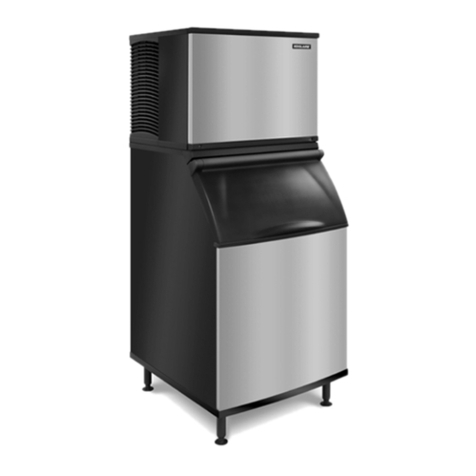SIMAG SD 22 User manual

SD 22
SD 23
SD 30
SD 40
SD 60
SD 80
SD 125
SD 210
Automatic cubers
Automatic Kegeleisbereiter
090091.05 - REV. 03/2004
090091.05 - REV. 05/2004

TABLE OF CONTENTS PAGE INHALTSVERZEICHNIS SEITE
GENERAL INFORMATION AND INSTALLATION 1 ALLGEMEINES UND INSTALLATION 14
Introduction 1 Einführung 14
Unpacking and inspection 1 Auspacken und Inspektion 14
Location and levelling 1 Maschinenplatz und lotgerechte Austellung 14
Electrical connection 1 Elektrische Anschlüße 15
Water supply and drain connection 2 Wasserversorgung und Abflußleitungen 15
Final check list 3 Schlußkontrollen 15
Installation practice 3 Installation 16
OPERATING INSTRUCTION 4 BETRIEBSANLEITUNG 17
Starp up 4 Inbetriebnahme 17
Operational checks 4 Ueberprüfung im Betrieb 17
OPERATING PRINCIPLES 6 FUNKTIONSSYSTEME 19
Freezing Cycle 6 Gefrierprozess 19
Harvest Cycle 6 Abtauprozess 19
Control sequence 7 Steuersequenzen 20
Electrical sequence 7 Sequenz Elektrische Bestandteile 20
Components description 8 Komponentenbeschrieb 21
Service diagnosis 10 Fonktionsfehler 23
MAINTENANCE AND CLEANING INSTRUCTIONS 12 WARTUNG UND REINIGUNGSANLEITUNG 25
General 12 Woraussetzung 25
Icemaker 12 Reinigung des Eisbereiters 25
Cleaning instructions of water system 12 Wartungs und Reinigungsanleitungen 25
A

SD 22
26
24
22
20
18
16
14
Kg.
25 10 °C20 15
°C
10
20
30
35
SD 23
SD 30 SD 40
SD 60 SD 80
SD 125 SD 210
Kg.
25 10 °C20 15
°C
10
20
30
35
26
24
22
20
18
16
14
26
24
22
20
18
16
14
Kg.
25 10 °C20 15
°C
10
20
30
35
Kg.
25 10 °C20 15
°C
10
20
30
35
28
26
24
22
20
18
16
34
32
30
28
26
24
22
20
Kg.
25 10 °C20 15
°C
10
20
30
35
Kg.
25 10 °C20 15
°C
10
20
30
35
32
30
28
26
24
22
20
Kg.
25 10 °C20 15
°C
10
20
30
35
Kg.
25 10 °C20 15
°C
10
20
30
35
25 10 °C20 15
°C
10
20
30
35
45
43
41
39
37
35
33
31
29
45
43
41
39
37
35
33
31
29
Kg.
25 10 °C20 15
°C
10
20
30
35
60
58
56
54
52
50
48
46
44
Kg.
60
58
56
54
52
50
48
46
44 25 10 °C20 15
Kg.
25 10 °C20 15
°C
10
20
30
35
80
78
76
74
72
70
68
66
64
62
60
58
Kg.
82
80
78
76
74
72
70
68
66
25 10 °C20 15
°C
10
20
30
35
Kg.
25 10 °C20 15
°C
10
20
30
35
210
200
190
180
170
160
150
140
130
120
Kg.
210
205
200
195
190
185
180
175
170
25 10 °C20 15
°C
10
20
30
35
Kg.
25 10 °C20 15
°C
10
20
30
35
150
145
140
135
130
125
120
115
110
105
100
95
Kg.
160
155
150
145
140
135
130
125
120
Ice making capacity - Eisproduktionskapazität
AIR COOLED MODELS - LUFTKÜHLUNG
WATER TEMPERATURE - WASSERTEMPERATUR
AMBIENT TEMPERATURE - RAUMTEMPERATUR
ICE PRODUCED PER 24 HRS. - EISWÜRFEL PRODUKTION IN 24 STD.
WATER COOLED MODELS - WASSERKÜHLUNG
WATER TEMPERATURE - WASSERTEMPERATUR
AMBIENT TEMPERATURE - RAUMTEMPERATUR
ICE PRODUCED PER 24 HRS. - EISWÜRFEL PRODUKTION IN 24 STD.
AIR COOLED MODELS - LUFTKÜHLUNG
WATER TEMPERATURE - WASSERTEMPERATUR
AMBIENT TEMPERATURE - RAUMTEMPERATUR
ICE PRODUCED PER 24 HRS. - EISWÜRFEL PRODUKTION IN 24 STD.
WATER COOLED MODELS - WASSERKÜHLUNG
WATER TEMPERATURE - WASSERTEMPERATUR
AMBIENT TEMPERATURE - RAUMTEMPERATUR
ICE PRODUCED PER 24 HRS. - EISWÜRFEL PRODUKTION IN 24 STD.
AIR COOLED MODELS - LUFTKÜHLUNG
WATER TEMPERATURE - WASSERTEMPERATUR
AMBIENT TEMPERATURE - RAUMTEMPERATUR
ICE PRODUCED PER 24 HRS. - EISWÜRFEL PRODUKTION IN 24 STD.
WATER COOLED MODELS - WASSERKÜHLUNG
WATER TEMPERATURE - WASSERTEMPERATUR
AMBIENT TEMPERATURE - RAUMTEMPERATUR
ICE PRODUCED PER 24 HRS. - EISWÜRFEL PRODUKTION IN 24 STD.
AIR COOLED MODELS - LUFTKÜHLUNG
WATER TEMPERATURE - WASSERTEMPERATUR
AMBIENT TEMPERATURE - RAUMTEMPERATUR
ICE PRODUCED PER 24 HRS. - EISWÜRFEL PRODUKTION IN 24 STD.
WATER COOLED MODELS - WASSERKÜHLUNG
WATER TEMPERATURE - WASSERTEMPERATUR
AMBIENT TEMPERATURE - RAUMTEMPERATUR
ICE PRODUCED PER 24 HRS. - EISWÜRFEL PRODUKTION IN 24 STD.
AIR COOLED MODELS - LUFTKÜHLUNG
WATER TEMPERATURE - WASSERTEMPERATUR
AMBIENT TEMPERATURE - RAUMTEMPERATUR
ICE PRODUCED PER 24 HRS. - EISWÜRFEL PRODUKTION IN 24 STD.
WATER COOLED MODELS - WASSERKÜHLUNG
WATER TEMPERATURE - WASSERTEMPERATUR
AMBIENT TEMPERATURE - RAUMTEMPERATUR
ICE PRODUCED PER 24 HRS. - EISWÜRFEL PRODUKTION IN 24 STD.
AIR COOLED MODELS - LUFTKÜHLUNG
WATER TEMPERATURE - WASSERTEMPERATUR
AMBIENT TEMPERATURE - RAUMTEMPERATUR
ICE PRODUCED PER 24 HRS. - EISWÜRFEL PRODUKTION IN 24 STD.
WATER COOLED MODELS - WASSERKÜHLUNG
WATER TEMPERATURE - WASSERTEMPERATUR
AMBIENT TEMPERATURE - RAUMTEMPERATUR
ICE PRODUCED PER 24 HRS. - EISWÜRFEL PRODUKTION IN 24 STD.
AIR COOLED MODELS - LUFTKÜHLUNG
WATER TEMPERATURE - WASSERTEMPERATUR
AMBIENT TEMPERATURE - RAUMTEMPERATUR
ICE PRODUCED PER 24 HRS. - EISWÜRFEL PRODUKTION IN 24 STD.
WATER COOLED MODELS - WASSERKÜHLUNG
WATER TEMPERATURE - WASSERTEMPERATUR
AMBIENT TEMPERATURE - RAUMTEMPERATUR
ICE PRODUCED PER 24 HRS. - EISWÜRFEL PRODUKTION IN 24 STD.
AIR COOLED MODELS - LUFTKÜHLUNG
WATER TEMPERATURE - WASSERTEMPERATUR
AMBIENT TEMPERATURE - RAUMTEMPERATUR
ICE PRODUCED PER 24 HRS. - EISWÜRFEL PRODUKTION IN 24 STD.
WATER COOLED MODELS - WASSERKÜHLUNG
WATER TEMPERATURE - WASSERTEMPERATUR
AMBIENT TEMPERATURE - RAUMTEMPERATUR
ICE PRODUCED PER 24 HRS. - EISWÜRFEL PRODUKTION IN 24 STD.
B

C
A
B
C
SD 22 - 23
➀➁➂
A
B
C
SD 30-40-60
➀➁➂
SD 22 (mm) SD 23 (mm) SD 30 (mm) SD 40 (mm) SD 60 (mm)
A 334 377 377 485 485
B 454 552 552 572 572
C 597 637 637 721 816
➊CORD SET -
ELEK. KABEL
➋Ø 20 WATER OUTLET -
WASSERABFLUSS
➌G3/4" WATER INLET -
WASSEREINLAUF

D
SD 80 (mm) SD 125 (mm) SD 210 (mm)
A 670 1045 1045
B 572 572 572
C 890 900 1050
➊CORD SET -
ELEK. KABEL
➋Ø 20 WATER OUTLET -
WASSERABFLUSS
➌G3/4" WATER INLET -
WASSEREINLAUF
➍G3/4" WATER OUTLET -
WASSERABFLUSS
*
➎G3/4" WATER INLET -
WASSEREINLAUF
*
* Water cooled only
- Nur wassergekuhlt
A
B
C
SD 80
➀➁➂➃ ➄
A
B
C
SD 125 - 210
➀➁➂➃ ➄

TECHNICAL SPECIFICATIONS - TECHNISCHE ANGABEN
OPERATING PRESSURES - BETRIEBSDRÜCKE
Discharge pressure - Hochdruckbereich
SD 22 SD 23 SD 30 SD 40 SD 60 SD 80 SD 125 SD 210
Air cooled (21°C)
Luftgekühlt (21°C) 8÷9 bar 8÷9 bar 8÷9,5 bar
8,5÷10 bar 8,5÷10 bar
8,5÷9,5 bar 15÷19,5 bar 16÷20 bar
Water cooled
Wassergekühlt 8,5÷10 bar 8,5÷10 bar 8,5÷10 bar 8,5÷10 bar 8,5÷10 bar 9,5 bar 17 bar 17 bar
Suction pressure - Niederdrück
Start / End of freezing cycle - Beginn / Ende der Gefrierfase
SD 22 SD 23 SD 30 SD 40 SD 60 SD 80 SD 125 SD 210
0,8÷0,1 bar 0,8÷0,1 bar 0,8÷0,1 bar 0,8÷0,1 bar 0,8÷0,1 bar 0,8÷0,1 bar 3,6÷1,5 bar 2,4÷1,3 bar
SD22 SD22W SD23 SD23W SD30 SD30W SD40 SD40W SD60 SD60W SD80 SD80W SD125 SD125W SD210 SD 210 W
Electric voltage 230/50/1 230/50/1 230/50/1 230/50/1 230/50/1 230/50/1 230/50/1 230/50/1
Normale Netzspannung -10 ÷+10% -10 ÷+10% -10 ÷+10% -10 ÷+10% -10 ÷+10% -10 ÷+10% -10 ÷+10% -10 ÷+10%
Condensation Air Water Air Water Air Water Air Water Air Water Air Water Air Water Air Water
Kühlung Luft Wasser Luft Wasser Luft Wasser Luft Wasser Luft Wasser Luft Wasser Luft Wasser Luft Wasser
Bin Capacity (kg)
Speiker Kapazität (kg) 6,5 12 12 17 20 30 50 80
Net weight (kg)
Netto Gewicht (kg) 28 33 40 45 48 61 94 131
Compressor power HP
Kompressorleistung PS 1/5 1/5 1/5 1/4 3/8 1/2 1 1.5
Running amps
Ampere 2.2 2.2 2.2 2.2 3.2 3.8 5.3 5.5
Start amps
Start Ampere 9 9 9 11 17 20 29 32
Power (Watts)
Leistung (Watt) 340 340 350 380 530 650 1200 2000
Power cons. in 24 hrs (Kwh)
Stromverbrauch in 24 std (Kwh) 7 7 7 7.5 10.5 13 24 35
Wire size (mm
2
)
Kabelanzahl (mm
2
) 3 x 1 3 x 1 3 x 1 3 x 1 3 x 1 3 x 1 3 x 1,5 3 x 1,5
Refrig. charge R 134a (gr)
Kühlmittel Füll. R 134a (gr) 210 190 190 190 260 240 280 240 300 270 450 300 – – – –
Refrig. charge R 404a (gr)
Kühlmittel Füll. R 404a (gr) – – – – – – – – – – – – 630 500 660 500
R
efrigerant metering device
Capillary tube Capillary tube Capillary tube Capillary tube Capillary tube Capillary tube Capillary tube Capillary tube
Kältemittel-Expansionssystem
Kapillarrohr Kapillarrohr Kapillarrohr Kapillarrohr Kapillarrohr Kapillarrohr Kapillarrohr Kapillarrohr
E

WIRING DIAGRAM - SCHALTUNGSSCHEMA
230/50/1
AIR & WATER COOLED - LUFT UND WASSERGEKÜHLT
SD 22 - SD 23 - SD 30 - SD 40
F

WIRING DIAGRAM - SCHALTUNGSSCHEMA
230/50/1
AIR COOLED - LUFTGEKÜHLT
SD 60
G

WIRING DIAGRAM - SCHALTUNGSSCHEMA
230/50/1
WATER COOLED - WASSERGEKÜHLT
SD 60
H

WIRING DIAGRAM - SCHALTUNGSSCHEMA
230/50/1
AIR & WATER COOLED - LUFT UND WASSERGEKÜHLT
SD 80
I

WIRING DIAGRAM - SCHALTUNGSSCHEMA
230/50/1
AIR & WATER COOLED - LUFT UND WASSERGEKÜHLT
SD 125 - SD 210
L

M
1. MASTER SWITCH - HAUPTSSCHALTER 9. OPERATING LIGHT -
2. CONDENSER THERMOSTAT - KONDENSATORTHERMOSTAT 10. TIMER MOTOR - TIMER MOTOR
3. BIN THERMOSTAT - SPEICHERTHERMOSTAT 11. HOT GAS VALVE - HEISSGASVENTIL
4. OUTER MICROSWITCH - AUSSERER MIKROSCHALTER 12. WATER INLET VALVE - WASSEREINLAUFVENTIL
5. EVAP. THERMOSTAT - VERDAMPFERTHERMOSTAT 13. WATER PUMP - WASSERPUMPE
6. INNER MICROSWITCH - INNERER MIKROSCHALTER 14. COMPRESSOR - KOMPRESSOR
7. COMPRESSOR SWITCH - KOMPRESSOR SCHALTER 15. FAN MOTOR - LUFTERMOTOR
8. PRESSURE CONTROL - PRESSOSTAT (SD 22 ÷60W) (SD 80 ÷210 A)
# SD 80 - 125 - 210 AIR COOLED ONLY
NUR SD 80 - 125 - 210 WASSERGEKÜHLTE VERSION
FiG. 1
FiG. 1
FiG. 3
FiG. 5 FiG. 6
FiG. 2
FiG. 4
1
FREEZING CYCLE
3
21 4
56 7
9 101112131415
2
NO NC
COM
3
2 4 NC NO
COM 2
1
31
12
45
8
1
FREEZING CYCLE - TIMING PHASE
3
21 4
56 7
9 101112131415
2
NO NC
COM
3
2 4 NC NO
COM 2
1
31
12
45
8
1
DEFROST CYCLE
3
21 4
56 7
9 101112131415
2
NO NC
COM
3
2 4 NC NO
COM 2
1
31
12
45
8
1
DEFROST CYCLE - BIN FULL
3
21 4
56 7
9 101112131415
2
NO NC
COM
3
2 4 NC NO
COM 2
1
31
12
45
8
1
FREEZING CYCLE - BIN FULL
3
21 4
56 7
9 101112131415
2
NO NC
COM
3
2 4 NC NO
COM 2
1
31
12
45
8
1
RINSING CYCLE
3
21 4
56 7
9 101112131415
2
NO NC
COM
3
2 4 NC NO
COM 2
1
31
12
45
8

GENERAL INFORMATION
AND INSTALLATION
A. INTRODUCTION
This manual provides the specifications and the
step-by-stepproceduresfortheinstallation,start-
up and operation, maintenance and cleaning for
the SIMAG SD Series Icemakers.
The SIMAG SD cubers are quality designed,
engineered and manufactured.
Their ice making systems are thoroughly tested
providing the utmost in flexibility to fit the needs
of a particular user.
NOTE.Toretainthesafetyandperformance
built into this icemaker, it is important that
installation and maintenance be conducted
in the manner outlined in this manual.
B. UNPACKING AND INSPECTION
1. Call your authorized SIMAG Distributor or
Dealer for proper installation.
2. Visually inspect the exterior of the packing
and skid. Any severe damage noted should be
reportedtothedeliveringcarrierandaconcealed
damageclaimformfilledinsubjettoinspectionof
the contents with the carrier’s representative
present.
3. a)Cutandremovetheplasticstripsecuring
the carton box to the skid.
b) Remove the packing nails securing the
carton box to the skid.
c)Cutopenthetopofthecartonandremove
the polystyre protection sheet.
d) Pull out the polystyre posts from the
corners and then remove the carton.
4. Removethefrontandtherearpanelsofthe
unit and inspect for any concealed damage.
Notify carrier of your claim for the concealed
damage as stated in step 2 above.
5. Remove all internal support packing and
masking tape.
6. Check that refrigerant lines do not rub
againstor touch other linesor surfaces, and that
the fan blades move freely.
7. Check that the compressor fits snugly onto
all its mounting pads.
8. See data plate on the rear side of the unit
and check that local main voltage corresponds
with the voltage specified on it.
CAUTION. Incorrect voltage supplied to
the icemaker will void your parts
replacement program.
9. Remove the manufacturer’s registration
card from the inside of the User Manual and fill-
in all parts including: Model and Serial Number
taken from the data plate.
Forward the completed self-addressed
registration card to SIMAG factory.
C. LOCATION AND LEVELLING
WARNING.ThisIceMakeris designedfor
indoorinstallationonly.Extendedperiods
of operation at temperature exceeding
the following limitations will constitute
misuse under the terms of the SIMAG
Manufacturer’sLimitedWarrantyresulting
in LOSS of warranty coverage.
1. Position the machine bin in the selected
permanent location and tighten the four legs
(SD 30-40-60-80-125-210).
Criteria for selection of location include:
a)Minimumroomtemperature10°C(50°F)
and maximum room temperature 40°C (100°F).
b) Water inlet temperatures: minimum 5°C
(40°F) and maximum 40°C (100°F).
c) Well ventilated location for air cooled
models (clean the air cooled condenser at
frequent intervals).
d)Serviceaccess:adequatespacemustbe
leftforallserviceconnectionsthroughtherearof
the ice maker. A minimum clearance of 15 cm
(6")mustbeleftatthesidesoftheunitforrouting
cooling air drawn into and exhausted out of the
compartment to maintain proper condensing
operation of air cooled models.
NOTE. With the unit in “built-in” conditions,
the ice production is gradually reduced in
respect to the levels shown in the graph, up
to a maximum of 10% at room temperatures
higher than 32
°
C.
The daily ice-making capacity is directly
related to the condenser air inlet temperatu-
re,watertemperatureandageofthemachine.
TokeepyourSIMAGCUBERatpeakperfor-
mance levels, periodic maintenance checks
must be carried out as indicated on this
manual.
2. Level the Icemaker in both the left to right
and front to rear directions by means of the
adjustable legs.
D. ELECTRICAL CONNECTIONS
See data plate for current requirements to
determine wire size to be used for electrical
connections. All SIMAG icemakers require a
solid earth wire.
All SIMAG ice machines are supplied from the
factory completely pre-wired and require only
electrical power connections to the wire cord
provided at the rear of the unit.
Page 1

GENERAL INFORMATION
AND INSTALLATION
A. INTRODUCTION
This manual provides the specifications and the
step-by-stepproceduresfortheinstallation,start-
up and operation, maintenance and cleaning for
the SIMAG SD Series Icemakers.
The SIMAG SD cubers are quality designed,
engineered and manufactured.
Their ice making systems are thoroughly tested
providing the utmost in flexibility to fit the needs
of a particular user.
NOTE.Toretainthesafetyandperformance
built into this icemaker, it is important that
installation and maintenance be conducted
in the manner outlined in this manual.
B. UNPACKING AND INSPECTION
1. Call your authorized SIMAG Distributor or
Dealer for proper installation.
2. Visually inspect the exterior of the packing
and skid. Any severe damage noted should be
reportedtothedeliveringcarrierandaconcealed
damageclaimformfilledinsubjettoinspectionof
the contents with the carrier’s representative
present.
3. a)Cutandremovetheplasticstripsecuring
the carton box to the skid.
b) Remove the packing nails securing the
carton box to the skid.
c)Cutopenthetopofthecartonandremove
the polystyre protection sheet.
d) Pull out the polystyre posts from the
corners and then remove the carton.
4. Removethefrontandtherearpanelsofthe
unit and inspect for any concealed damage.
Notify carrier of your claim for the concealed
damage as stated in step 2 above.
5. Remove all internal support packing and
masking tape.
6. Check that refrigerant lines do not rub
againstor touch other linesor surfaces, and that
the fan blades move freely.
7. Check that the compressor fits snugly onto
all its mounting pads.
8. See data plate on the rear side of the unit
and check that local main voltage corresponds
with the voltage specified on it.
CAUTION. Incorrect voltage supplied to
the icemaker will void your parts
replacement program.
9. Remove the manufacturer’s registration
card from the inside of the User Manual and fill-
in all parts including: Model and Serial Number
taken from the data plate.
Forward the completed self-addressed
registration card to SIMAG factory.
C. LOCATION AND LEVELLING
WARNING.ThisIceMakeris designedfor
indoorinstallationonly.Extendedperiods
of operation at temperature exceeding
the following limitations will constitute
misuse under the terms of the SIMAG
Manufacturer’sLimitedWarrantyresulting
in LOSS of warranty coverage.
1. Position the machine bin in the selected
permanent location and tighten the four legs
(SD 30-40-60-80-125-210).
Criteria for selection of location include:
a)Minimumroomtemperature10°C(50°F)
and maximum room temperature 40°C (100°F).
b) Water inlet temperatures: minimum 5°C
(40°F) and maximum 40°C (100°F).
c) Well ventilated location for air cooled
models (clean the air cooled condenser at
frequent intervals).
d)Serviceaccess:adequatespacemustbe
leftforallserviceconnectionsthroughtherearof
the ice maker. A minimum clearance of 15 cm
(6")mustbeleftatthesidesoftheunitforrouting
cooling air drawn into and exhausted out of the
compartment to maintain proper condensing
operation of air cooled models.
NOTE. With the unit in “built-in” conditions,
the ice production is gradually reduced in
respect to the levels shown in the graph, up
to a maximum of 10% at room temperatures
higher than 32
°
C.
The daily ice-making capacity is directly
related to the condenser air inlet temperatu-
re,watertemperatureandageofthemachine.
TokeepyourSIMAGCUBERatpeakperfor-
mance levels, periodic maintenance checks
must be carried out as indicated on this
manual.
2. Level the Icemaker in both the left to right
and front to rear directions by means of the
adjustable legs.
D. ELECTRICAL CONNECTIONS
See data plate for current requirements to
determine wire size to be used for electrical
connections. All SIMAG icemakers require a
solid earth wire.
All SIMAG ice machines are supplied from the
factory completely pre-wired and require only
electrical power connections to the wire cord
provided at the rear of the unit.
Page 1

Make sure that the ice machine is connected to
its own circuit and individually fused (see data
plate for fuse size).
Themaximumallowablevoltagevariationshould
not exceed -10% and +10% of the data plate
rating. Low voltage can cause faulty functioning
and may be responsible for serious damage to
the overload switch and motor windings.
NOTE. All external wiring should conform to
national, state and local standards and
regulations.
Check voltage on the line and the ice maker’s
data plate before connecting the unit.
E. WATER SUPPLY AND DRAIN
CONNECTIONS
GENERAL
When choosing the water supply for the cuber
consideration should be given to:
a) Length of run
b) Water clarity and purity
c) Adequate water supply pressure
Sincewateristhemostimportantsingleingredient
inproducingiceyoucannotemphasizetoomuch
the three items listed above.
Low water pressure, below 1 bar may cause
malfunction of the ice maker unit.
Water containing excessive minerals will tend to
produce cloudy colored ice cubes, plus scale
build-upontheinteriorpartsofthewatersystem.
WATER SUPPLY
Connect the 3/4" GAS male of the water inlet
fitting,usingthefoodgradeflexibletubingsupplied
with the machine, to the cold water supply line
with regular plumbing fitting and a shut-off valve
installed in an accessible position between the
water supply line and the unit.
If water contains a high level of impurities, it is
advisable to consider the installation of an
appropriate water filter or conditioner.
WATERSUPPLY-WATERCOOLEDMODELS
(SD 80-125-210)
ThewatercooledversionsofSIMAGIce Makers
requiretwoseparateinletwatersupplies,onefor
the water making the ice and the other for the
water cooled condenser.
Connect the 3/4" GAS male fitting of the water
inlet, using the flexible tubing supplied with the
unit, to the cold water supply line with regular
plumbing fitting and a shut-off valve installed in
anaccessiblepositionbetweenthewatersupply
line and the unit.
WATER DRAIN
Connect the drain fitting with a plastic tube to an
open trapped and vented drain. When the drain
is a long run, allow 3 cm pitch per meter (1/4"
pitch per foot).
On water cooled versions, the water drain line
from the condenser is internally connected with
the drain fitting of the unit.
It is strongly recommended therefore to install a
vertical open vent on unit drain line high point to
ensure good draining and to direct the drain line
to a trapped and vented floor drain receptacle.
NOTE.Thewatersupplyandthewaterdrain
must be installed to conform with the local
code. In some case a licensed plumber and/
or a plumbing permit is required.
Page 2

G. INSTALLATION PRACTICE
1. Hand shut-off valve
2. Water filter
3. Water supply line (flexible hose)
4. 3/4" GAS male fitting
5. Vented drain
6. Open trapped vented drain
7. Drain fitting
8. Main switch
9. Power line
7. Havetheboltsholdingthecompressordown
been checked to ensure that the compressor is
snugly fitted onto the mounting pads?
8. Check all refrigerant lines and conduit lines
to guard against vibrations and possible failure.
9. Have the bin liner and cabinet been wiped
clean?
10. Has the owner/user been given the User
Manualandbeeninstructedontheimportanceof
periodic maintenance checks?
11. HastheManufacturer’sregistrationcardbeen
filled in properly? Check for correct model and
serial number against the serial plate and mail
the registration card to the factory.
12. Hasthe owner been given the name and the
phonenumberofthe authorized SIMAG Service
Agency serving him?
F. FINAL CHECK LIST
1. Is the unit in a room where ambient
temperatures are within a minimum of 10°C
(50°F) even in winter months?
2. Is there at least a 15 cm (6") clearance
around the unit for proper air circulation?
3. Is the unit level? (IMPORTANT)
4. Have all the electrical and plumbing
connectionsbeenmade,andisthe water supply
shut-off valve open?
5. Has the voltage been tested and checked
against the data plate rating?
6.
Has the water supply pressure been checked
to ensure a water pressure of at least 1 bar
(14 psi)? Open the shut-off valve and verify the
absence of water losses from the connections.
WARNING. This icemaker is not designed for outdoor installation and will not function in
ambient temperatures below 10°C (50°F) or above 40°C (100°F).
This icemaker will malfunction with water temperatures below 5°C (40°F) or above 40°C
(100°F).
Page 3

OPERATING
INSTRUCTIONS
START UP
Afterhavingcorrectlyinstalledtheicemakerand
completed the plumbing and electrical
connections, perform the following “Start-up”
procedure.
A. Puttheicemakerinoperationbymovingthe
unit master switch, located on the cabinet front,
to the ON position.
NOTE. The icemaker control is factory set
with the timer microswitches actuators
dropped off into the initial point of the cam
slot. This setting position allows a proper
water filling.
The unit starts operating in the “defrost cycle”
with the following components being activated:
THE WATER INLET SOLENOID VALVE
THE HOT GAS SOLENOID VALVE
THE CONTACTOR COIL (SD 80-125-210)
THE FAN MOTOR (only SD 22÷40) air cooled
THE COMPRESSOR
THE TIMER MOTOR
B. During the water filling operation, check to
see that the incoming water dribblers, through
the evaporator platen dribbler holes, down into
the sump reservoir to fill it up and also that the
incoming surplus of water flows out through the
overflow pipe into the drain line.
NOTE. If, in the defrost cycle length, the
machine sump reservoir does not get filled
with water up to the rim of the overflow pipe,
removethefrontpanelandrotatetheshaftof
thetimer soto causethe droppingof thetwo
microswitches actuators into the beginning
of the cam slot and check for:
1. The water pressure of the water supply
line, it must be at least 1 bar (14 psig)
Minimum (Max 5 bar-70 psig).
2. The filtering device installed in the water
line that may reduce the water pressure
below the Minimum value of 1 bar (14 psig).
3. Any clogging situation in the water circuit
like the inlet water strainer and/or the flow
control.
OPERATIONAL CHECKS
C. At completion of the water filling phase the
unit initiate automatically the first freezing cycle
with the start up of (Fig.1):
COMPRESSOR
CONTACTOR COIL (SD 80-125-210)
WATER PUMP
FAN MOTOR (in air cooled version)
D. Check to see through the ice discharge
openingthatthespraysystemiscorrectlyseated
and that the water jets uniformely reach the
interior of the inverted mold cups or the exterior
of the evaporator tips; also make sure that the
plastic curtain is hanging freely and there is not
excessive water spilling through it.
E. Theicemakingprocesstakesplacethereby,
withthe water sprayed intothemolds or onto the
tips that gets gradually refrigerated by the heat
exchange with the refrigerant flowing into the
evaporator serpentine.
During the first portion of the freezing cycle, the
timer assy is standing-by with its microswitches
actuators resting on the raised cam profile
(positionthatcorrespondtotheendofthedefrost
cycle).
F. Then,asthecubesizecontrolcut-inpointis
reachedbytheevaporatortemperaturethecontrol
of the cycle is passed to the timer assy. Whose
raisedcamslowlyrotatestocontinuethefreezing
cycle (2nd phase) up to its completition.
The components in operation during this 2nd
phase of the cycle are (Fig.2):
COMPRESSOR
CONTACTOR COIL (SD 80-125-210)
WATER PUMP
FAN MOTOR (in air cooled version)
TIMER MOTOR
G. After about 18÷20 minutes from the
beginning of the freezing cycle, in an hypothetic
ambient temperature of 21°C, the defrost cycle
takes place with the hot gas and the water inlet
valves being simoultaneously activated.
Theelectricalcomponentsinoperationare(Fig.3):
COMPRESSOR
CONTACTOR COIL (SD 80-125-210)
WATER INLET SOLENOID VALVE
HOT GAS VALVE
TIMER MOTOR
FAN MOTOR (only SD 22÷40) air cooled
H. Check, during the defrost cycle, that the
incoming water flows correctly into the sump
reservoir in order to refill it and that the surplus
overflows through the overflow drain tube.
I. Checkthetextureoficecubesjustreleased.
They have to be of the right size with a thickness
of about 7÷8 mm.
Iftheicecubes have not the correct size, waitfor
a second harvest before attempting any
adjustment by setting the cube size control.
Page 4

By rotating the control setting screw clockwise
the ice cube thickness can be increased; on the
contrarythethicknesscanbereducedbyturning
the setting screw counterclockwise.
If the ice cubes are shallow and cloudy, it is
possible that the ice maker runs short of water
during the freezing cycle second phase or, the
quality of the supplied water requires the use of
an appropriate water filter or conditioner.
J. Withtheicemakerintheharvestcycle,hold
iceagainstthe bin thermostat controlbulbtotest
its shut off (Fig.4). This should cause the ice
maker to shut OFF after 30 seconds, 1 minute at
themost,namelywhenthecontrolbulbtempera-
ture drops to reach +1°C.
NOTE. In case this test is performed during
thefreezingcycle,theunitwillshutOFFonly
at the end of the freeezing cycle and exactly
whenthetimerswitchactuatorsdrop-offinto
the cam slot (Fig.5).
Within minutes after the ice is removed from the
sensingbulb,thebulbwillwarmuptoreach+4°C
and consequently will cause the icemaker to
restart from the harvest (defrost) cycle.
K. Instruct the owner/user on the general
operation of the ice machine and about the
cleaning and care it requires.
Page 5

PRINCIPLE OF OPERATION
IntheSIMAG cubeicemakers thewater usedto
make the ice is kept constantly in circulation by
an electric water pump which primes it to the
spray system nozzles from where it is diverted
into the molds of the evaporator.
Asmallquantityofthesprayedwaterfreezesinto
ice; the rest of it cascades by gravity into the
sump assembly below for recirculation.
FREEZING CYCLE
The hot gas refrigerant discharged out from the
compressorreachesthecondenserwhere,being
cooleddown,condensesintoliquid.Flowinginto
the liquid line it passes through the drier filter,
thenitgoesallthewaythroughthecapillarytube
where, due to the heat exchanging action, it
loosessomeofitsheatcontentsothatitspressure
and temperature are lowered as well.
Next the refrigerant enters into the evaporator
serpentine (which has a larger I.D. then the
capillary) and starts to boil off; this reaction is
emphasized by the heat transferred by the
sprayed water.
The refrigerant then increases in volume and
changes entirely into vapor.
The vapor refrigerant then passes through the
suction accumulator (used to prevent that any
small amount of liquid refrigerant may reach the
compressor)andthroughthesuctionline.Inboth
theaccumulatorandthesuctionlineitexchanges
heatwiththerefrigerantflowingintothecapillary
tube (warmer), before to be sucked in the
compressor and to be recirculated as hot
compressed refrigerant gas.
Thefreezingcycleiscontrolledbytheevaporator
thermostat(whichhasits bulbincontactwiththe
evaporatorserpentine)thatdeterminesthelength
of its first portion of the cycle.
When the temperature of the evaporator
thermostat bulb drops to a pre-set value, the
evaporatorthermostatchangesitscontacts(from
3-4 to 3-2) suppling power to the finishing timer
thattakesthecontrolofthesecondtimedportion
of the freezing cycle up to its completion.
The length of this second timed portion of the
freezing cycle is pre-fixed and related to the
setting of the upper part of the timer cam.
The electrical components in operation during
the freezing cycle are:
COMPRESSOR
CONTACTOR COIL (SD 80-125-210)
FAN MOTOR (in air cooled version)
WATER PUMP
and during the second phase of freezing cycle
(Time mode) they are joined by the
TIMER
On the SD 60, SD 80, SD 125 and SD 210 air
cooledtherefrigerantheadpressure,inthecourse
ofthe freezing cycle,ranges between 8÷10bars
SD 60, 8÷9,5 bars SD 80 and 15,5÷20 bars
SD 125-210 being controlled by the hi-pressure
control.
When the discharge pressure rises up to a pre
setvalue,thepressurecontrolclosesitselectrical
contacts suppling power to the FAN MOTOR.
As soon as the discharged refrigerant pressure
drops, the pressure control opens its contacts to
temporarelyde-energizethefanmotor.Onothers
air cooled models (SD 22÷40) the fan motor is
constantlyactivatedandretaintheheadpressure
between 8÷10 bars (110÷140 psig).
OnthemodelsfromSD22toSD60watercooled
version the same hi-pressure control is used to
intermittently energize a water solenoid valve
locatedonthewatersupplylinetothecondenser.
On the other models SD 80-125-210, in water
cooled version, the discharge pressure is kept
constantbythewaterregulatingvalvethatmeters
the water flow to the condenser.
NOTE.Incaseofshortage/insufficientcooling
wateror aircondenser dirty, theoperation of
thesafetydevicebyhandresetwillstopthe
machine as soon as the temperature reach
70/75
°
C (160/170
°
F) or the corresponding
pressure. After eliminated the cause of the
stop, put the machine in operation by
pushing the reset button of the safety
thermostat or pressure switch across the
holesinthedown/rightsideofthefrontpanel
or removing it.
At the start of the freezing cycle the refrigerant
suctionorlo-pressure lowersrapidlyto0,8 bars
(11 psig) SD 22÷80, 3,6 bars (50 psig) SD 125
and 2,4 bars (34 psig) SD 210 then it declines
gradually - in relation with the growing of the ice
thickness - to reach, at the end of the cycle,
approx. 0,1 bars (1,4 psig) SD 22÷80, 1,5 bars
(21psig)SD125,and1,3bars(18psig)SD210
with the cubes fully formed in the cup molds.
Thetotallengthofthefreezingcyclerangesfrom
18 to 20 minutes.
DEFROST OR HARVEST CYCLE
As the electric timer has carried the system
throughout the second phase of freezing cycle,
the defrost cycle starts.
NOTE.Thelengthofthedefrostcycleis pre-
determinedbythesettingofthelowerportion
of the timer cam.
In case it is possible to modify the defrost
cycle length through its setting screw.
ATTENTION. The defrost period is the
most critical for the icemaker main
components expecially the compressor.
To avoid to abuse of them it is strongly
recommended to limit the harvest cycle
extension to 4 minutes at the most.
The electrical components in operation during
this phase are:
COMPRESSOR
Page 6

CONTACTOR COIL (SD 80-125-210)
FAN MOTOR (only SD 22÷40) air cooled
WATER INLET SOLENOID VALVE
HOT GAS SOLENOID VALVE
TIMER MOTOR
The incoming water, passing through the water
inlet valve and in its incorporated flow control
(outlet),runsovertheevaporatorplatenandthen
flows by gravity through the dribbler holes down
into the sump/reservoir.
Thewaterfillingthesump/reservoirforcespartof
theleft-overwaterfromthepreviousbatchtorun
out to the waste through the overflow pipe. This
overflow limits the level of the sump water which
will be used to produce the next batch of ice
cubes.
Meanwhile,therefrigerantashotgas,discharged
from the compressor, flows through the hot gas
valve directly into the evaporator serpentine by-
passing the condenser.
The hot gas circulating into the serpentine of the
evaporator warms up the copper molds or the
tips causing the defrost of the ice cubes. The ice
cubes, released from the molds, drop by gravity
ontoaslantedgridchute,thenthroughacurtained
opening they fall into the storage bin.
At the end of the defrost cycle, both the hot gas
andthewaterinletvalvescloseandthemachine
starts again a new freezing cycle.
OPERATION - CONTROL SEQUENCE
At the start of freezing cycle, the evaporator
thermostat controlsthe length of thefirst part of
the freezing cycle. As its bulb senses a
predeterminedtemperature,itclosesitscontacts
tosupplypowertothetimermotorwhich,inturn,
takes over the control of the freezing cycle.
Thissecondpartofthecyclehasapre-fixedtime
durationwhichisreliedtothesettingextensionof
the cam high profile.
NOTE. The evaporator thermostat is factory
set to the number 4 of its setting dial.
In case it is required the setting of the
evaporatorthermostatcanbemadebyturning
its adjusting screw located on front side.
Withaclockwiserotationofthesettingscrew
the thermostat cut IN temperature will be
lowered (longer freezing cycle - thicker ice
cube)while,withacounterclockwiserotation
of the screw, the Cut IN temperature rises
(shorter freezing cycle - thiner ice cube).
Once completed the freezing cycle 2nd phase
thesystemswitchesautomaticallyintothedefrost
cycle which has a pre-fixed length as well.
Atcompletionofthe defrostperiodtheunitstarts
again a new freezing cycle.
OPERATION - ELECTRICAL SEQUENCE
The following charts illustrate which switches
and which components are ON or OFF during a
particular phase of the icemaking cycle.
Refer to the wiring diagram for a reference.
NOTE.Thewiringdiagramshowstheunitas
itisintheEvaporatorThermostatmodeofthe
Freezing Cycle.
BEGINNING FREEZE
Electrical components (Loads)....... ON OFF
Compressor........................................ •
Fan motor........................................... •
Hot gas valve ..................................... •
Water inlet valve................................. •
Water pump........................................ •
Contactor coil ..................................... •
Timer motor........................................ •
Electric Controls .............................. ON OFF
Conctats 3-4 evaporator thermostat .. •
Conctats 3-2 evaporator thermostat .. •
Bin thermostat .................................... •
Conctats COM-NO timer microswitch •
Conctats COM-NC timer microswitch •
Pressure control (SD22÷60W) (SD60÷210A)
•
TIMED FREEZE
Electrical components (Loads)....... ON OFF
Compressor........................................ •
Fan motor........................................... ••
Hot gas valve ..................................... •
Water inlet valve................................. •
Water pump........................................ •
Contactor coil ..................................... •
Timer motor........................................ •
Electric Controls .............................. ON OFF
Conctats 3-4 evaporator thermostat .. •
Conctats 3-2 evaporator thermostat .. •
Bin thermostat .................................... •
Conctats COM-NO timer microswitch •
Conctats COM-NC timer microswitch •
Pressure control (SD22÷60W) (SD60÷210A)
••
I°PORTION HARVEST CYCLE
Electrical components (Loads)....... ON OFF
Compressor........................................ •
Fan motor (SD 22÷40 ON)................. •
Hot gas valve ..................................... •
Water inlet valve................................. •
Water pump........................................ •
Contactor coil ..................................... •
Timer motor........................................ •
Electric Controls .............................. ON OFF
Conctats 3-4 evaporator thermostat .. •
Conctats 3-2 evaporator thermostat .. •
Bin thermostat .................................... •
Conctats COM-NO timer microswitch •
Conctats COM-NC timer microswitch •
Pressure control (SD22÷60W) (SD60÷210A)
•
Page 7
This manual suits for next models
7
Table of contents
Languages:
Other SIMAG Ice Maker manuals
